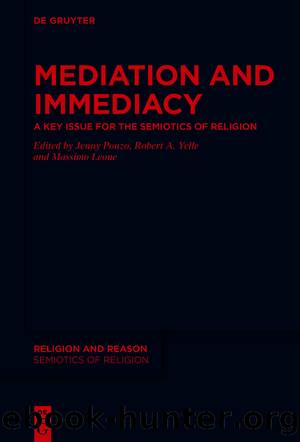Mediation and Immediacy by Jenny Ponzo Robert A. Yelle Massimo Leone

Author:Jenny Ponzo, Robert A. Yelle, Massimo Leone
Language: eng
Format: epub
Publisher: De Gruyter
Published: 2020-12-07T11:46:58.101000+00:00
Notes
1 The Upaniá¹£ads themselves are called âVedÄntaâ (âend of the Vedaâ) as well as their exegesis and systematization by Åaá¹ kara and others. Usually it is the latter, being one of the six schools of Indian philosophy, that is referred to as âVedÄnta.â It is based on three major sources: the Upaniá¹£ads, the BhagavadgÄ«tÄ and the BrahmasÅ«tras.
2 See for this and other statements and quotes Swami Tapovan (2015: 11âââ20), who gives many more examples of negative and affirmative statements.
3 Yad eva sÄká¹£Äd-aparoká¹£Äd-brahma ya ÄtmÄ sarvÄntaraḥ taá¹ me vyÄcaká¹£veti [â¦] eá¹£a ta ÄtmÄ sarvÄntaraḥ.
4 See also Chakraborty (2015: 88âââ89).
5 Similarly Tapovan (2015: 16), referring to TaittirÄ«ya Up. On the knowledge-bliss nature of Brahman and the self and its consummation as a sign of liberation see also Bá¹hadÄraá¹yaka Up. BhÄá¹£ya 3.9.28,7. Åaá¹ kara comments, since supreme bliss is Brahman/Ätmanâs very nature, it is directly experienced at all times. However, overlooking all his commentaries the term âblissâ (Änanda) is sparingly used; the prime term is cit (consciousness, awareness) along with terms of âself-luminosityâ (svayaá¹-jyotiḥ; svataḥ-prakÄÅa), pure existence/being(ness) (sat, satyam) and limitlessness (nityam, anantam), and tropes like âreveling in oneâs selfâ (Ätmarati, ÄtmakrÄ«da) and âhaving done what is to be doneâ (ká¹taká¹tyaḥ).
6 These terms and synonymous formulas (like svataḥ-siddhiḥ, âself-accomplished,â etc.) are frequently used in both parts of the UpadeÅa SÄhasrÄ« (âUSâ) and summarize its essential teaching: see US, Gadyabandha 2.79; 2.91, 93, 105, 107, and Padyabandha 10.3; 11.11; 17.69; 18.26, 98, 101, 200, 220. See also Åaá¹ karaâs Bá¹hadÄraá¹yaka Up. BhÄá¹£ya 4.3.7.
7 Bá¹hadÄraá¹yaka Up. BhÄá¹£ya 3.9.26.
8 See Åaá¹ karaâs US, Padyabandha 15.39, 18.28, 18.30, 19.24, and for the whole argument Wilke and Moebus 2011: 589âââ615.
9 US, Padyabandha 18.57; transl. Wilke and Moebus 2011: 591.
10 The tat tvam asi hermeneutics are elaborately dealt with in US, Padyabandha 18 and 12.1âââ19 (where mostly verbal forms like laká¹£ayeyuḥ or laká¹£ayet are used, for instance in 18.29 and 18.80); see also Åaá¹ karaâs commentary on ChÄndogya Up. 6.8.7âff. (which presents the same interpretation, but without using the technical term). The full laká¹£aá¹a theory in the context of tat tvam asi hermeneutics was developed later (post-Åaá¹ kara) in texts like SadÄnandaâs VedÄntasÄra.
11 See for the following Åaá¹ karaâs ChÄndogya Up. BhÄá¹£ya 6.16.3.
12 Åaá¹ kara reads ChÄndogya Up. 6.8âââ16, in which tat tvam asi appears nine times, as a conceptual whole. To determine relevant text units for the meaning of single phrases is vital to the Advaita-VedÄnta hermeneutics. Similarly, the teaching by repetitions and similes is important, a strategy for which ChÄndogya Up. 6.8âââ16 was the first-hand model.
13 An almost identical statement can be found in US, Padyabandha 18.200. The chapter 18 deals extensively with the tat tvam asi and its correct understanding. The foundational scriptural authority for the self-effulgent light of tvam which corresponds with tat is found in the Bá¹hadÄraá¹yaka Up. 4.3.7 and Åaá¹ karaâs extensive commentary.
14 The method of anvaya-vyatireka (continuity-and-discontinuity; âgoing through and leavingâ) is mentioned several times in the US (e.âg. Padyabandha 18.96âââ97, 170âââ180, 189) and also applied in SureÅvaraâs Naiá¹£karmyasiddhi (Halbfass 1991:162âââ180). It goes originally back to grammar (denoting here root form and flections).
Download
This site does not store any files on its server. We only index and link to content provided by other sites. Please contact the content providers to delete copyright contents if any and email us, we'll remove relevant links or contents immediately.
Cecilia; Or, Memoirs of an Heiress — Volume 1 by Fanny Burney(32434)
Cecilia; Or, Memoirs of an Heiress — Volume 2 by Fanny Burney(31869)
Cecilia; Or, Memoirs of an Heiress — Volume 3 by Fanny Burney(31852)
The Lost Art of Listening by Michael P. Nichols(7406)
Asking the Right Questions: A Guide to Critical Thinking by M. Neil Browne & Stuart M. Keeley(5632)
We Need to Talk by Celeste Headlee(5542)
On Writing A Memoir of the Craft by Stephen King(4863)
Dialogue by Robert McKee(4321)
Pre-Suasion: A Revolutionary Way to Influence and Persuade by Robert Cialdini(4144)
I Have Something to Say: Mastering the Art of Public Speaking in an Age of Disconnection by John Bowe(3840)
Elements of Style 2017 by Richard De A'Morelli(3306)
The Book of Human Emotions by Tiffany Watt Smith(3237)
Fluent Forever: How to Learn Any Language Fast and Never Forget It by Gabriel Wyner(3028)
Name Book, The: Over 10,000 Names--Their Meanings, Origins, and Spiritual Significance by Astoria Dorothy(2939)
Good Humor, Bad Taste: A Sociology of the Joke by Kuipers Giselinde(2903)
Why I Write by George Orwell(2874)
The Art Of Deception by Kevin Mitnick(2735)
The Grammaring Guide to English Grammar with Exercises by Péter Simon(2706)
Ancient Worlds by Michael Scott(2622)
